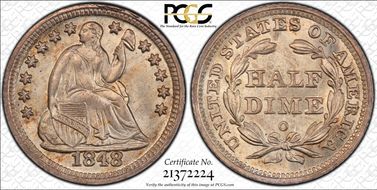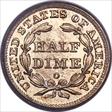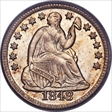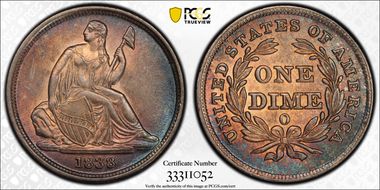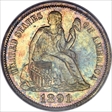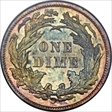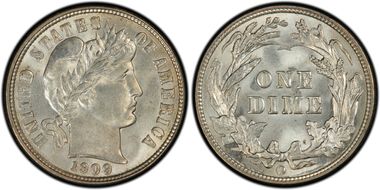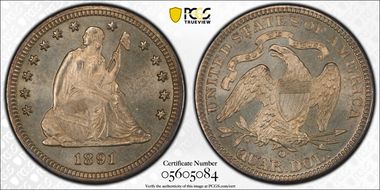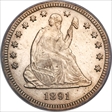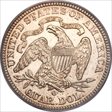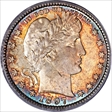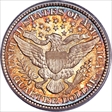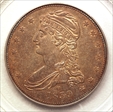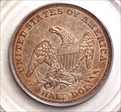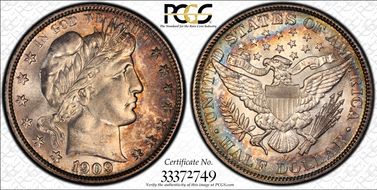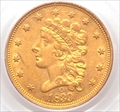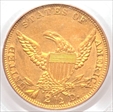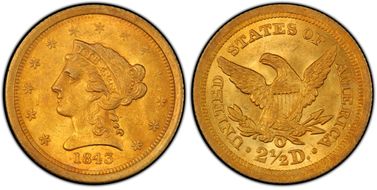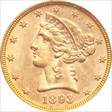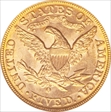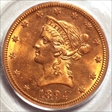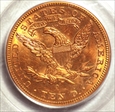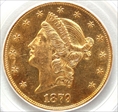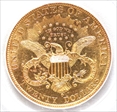The Wind River Collection 的钱币相册
Many collectors consider the no stars seated coins to be one of the more beautiful designs ever used on our circulating coinage. The New Orleans no stars half dime is a one-year type coin that is quite scarce in all grades and much tougher to find than the 1838-O dime. Mintage was only about 70,000. Two varieties are known. The variety in this collection is a V-1 with the date level or nearly so. The date on the V-2 slopes up from left to right. In addition, the V-2 usually has extensive die rust on the lower part of the obverse and should be graded based on the reverse. The V-2 has been considered rarer than the V-1, but in uncirculated condition the two varieties are comparable in rarity and, of course, quite scarce.
Many collectors consider the no stars seated coins to be one of the more beautiful designs ever used on our circulating coinage. The New Orleans no stars half dime is a one-year type coin that is quite scarce in all grades and much tougher to find than the 1838-O dime. Mintage was only about 70,000. Two varieties are known. The variety in this collection is a V-1 with the date level or nearly so. The date on the V-2 slopes up from left to right. In addition, the V-2 usually has extensive die rust on the lower part of the obverse and should be graded based on the reverse. The V-2 has been considered rarer than the V-1, but in uncirculated condition the two varieties are comparable in rarity and, of course, quite scarce.
Many collectors consider the no stars seated coins to be one of the more beautiful designs ever used on our circulating coinage. The New Orleans no stars half dime is a one-year type coin that is quite scarce in all grades and much tougher to find than the 1838-O dime. Mintage was only about 70,000. Two varieties are known. The variety in this collection is a V-1 with the date level or nearly so. The date on the V-2 slopes up from left to right. In addition, the V-2 usually has extensive die rust on the lower part of the obverse and should be graded based on the reverse. The V-2 has been considered rarer than the V-1, but in uncirculated condition the two varieties are comparable in rarity and, of course, quite scarce.
The 1848-O half dime it is one of the more common dates of this type. This coin is a Valentine-2 (V-2) with a small O mint mark which is the scarcest of the three mint mark sizes. It was purchased from the Gardner collection and is one of the finest know half dimes of this date. A landmark article on the eight different 1848-O die varieties was published by Bill Harmon in the Gobrecht Journal (#56) making this date one of the more popular ones to collect by die variety.
The 1848-O half dime it is one of the more common dates of this type. This coin is a Valentine-2 (V-2) with a small O mint mark which is the scarcest of the three mint mark sizes. It was purchased from the Gardner collection and is one of the finest know half dimes of this date. A landmark article on the eight different 1848-O die varieties was published by Bill Harmon in the Gobrecht Journal (#56) making this date one of the more popular ones to collect by die variety.
The 1848-O half dime it is one of the more common dates of this type. This coin is a Valentine-2 (V-2) with a small O mint mark which is the scarcest of the three mint mark sizes. It was purchased from the Gardner collection and is one of the finest know half dimes of this date. A landmark article on the eight different 1848-O die varieties was published by Bill Harmon in the Gobrecht Journal (#56) making this date one of the more popular ones to collect by die variety.
This half dime was purchased from the Gardner IV auction and is a Valentine-1a variety. These coins were produced for three years at the New Orleans and the Philadelphia mints. All three New Orleans issues are scarce in high grade with this date, the 1855-O, being the rarest with arrows type and having the lowest mintage. As a late die state coin, it shows extensive cracking and rust indicating imminent failure of the die.
This half dime was purchased from the Gardner IV auction and is a Valentine-1a variety. These coins were produced for three years at the New Orleans and the Philadelphia mints. All three New Orleans issues are scarce in high grade with this date, the 1855-O, being the rarest with arrows type and having the lowest mintage. As a late die state coin, it shows extensive cracking and rust indicating imminent failure of the die.
The 1860-O half dime is yet another New Orleans type coin produced for just one year. However, unlike many of the other unique year New Orleans type coins it is one of the more common half dimes and relatively available in MS-65 and even higher.
This 1838-O dime is yet another one-year New Orleans type coin. As with the 1838-O half dime it's cameo-like design without stars is greatly appreciated by many collectors. Two varieties are known: one with a repunched mintmark (Fortin-101 or F-101) and one without a repunched mintmark (F-102). This, is the variety without the repunched mintmark. The 1838-O dime becomes scarcer in higher grades, but it is much more common than it's little sister, the 1838-O half dime in all grades.
This "no drapery" dime is one of my favorite coins in my collection because it really jump started my interest in collecting the coins of New Orleans. Its rarity, beauty, and formerly underrated value made me aware that I could still afford to add some of the finest New Orleans coins to my collection, if I could just find them. In addition, I consider the no drapery design and the no stars coinage to be the finest examples of seated coinage. Walter Breen, in his Encyclopedia, provides some additional entertaining and acerbic comments about subsequent changes wrought by Hughes on these early artistic Gobrecht designs. Eleven die varieties of this date are currently known. This 1840-O dime variety is a Fortin-106 (F-106) with a medium O mintmark. It is the finest known example of this variety and one of the finest known of the date.
This "no drapery" dime is one of my favorite coins in my collection because it really jump started my interest in collecting the coins of New Orleans. Its rarity, beauty, and formerly underrated value made me aware that I could still afford to add some of the finest New Orleans coins to my collection, if I could just find them. In addition, I consider the no drapery design and the no stars coinage to be the finest examples of seated coinage. Walter Breen, in his Encyclopedia, provides some additional entertaining and acerbic comments about subsequent changes wrought by Hughes on these early artistic Gobrecht designs. Eleven die varieties of this date are currently known. This 1840-O dime variety is a Fortin-106 (F-106) with a medium O mintmark. It is the finest known example of this variety and one of the finest known of the date.
This date is one of the commonest New Orleans seated dimes, but it is not usually encountered above MS-65. It was purchased at the Gardner IV auction.
This date is one of the commonest New Orleans seated dimes, but it is not usually encountered above MS-65. It was purchased at the Gardner IV auction.
Only two dates are available for this New Orleans type coin: 1853-O and 1854-O. My coin is one of the few uncirculated 1853-O dimes know today and is, by far, the rarest date of this type. It was the lowest mintage, but it is much scarcer than the mintage figures would suggest.
Only two dates are available for this New Orleans type coin: 1853-O and 1854-O. My coin is one of the few uncirculated 1853-O dimes know today and is, by far, the rarest date of this type. It was the lowest mintage, but it is much scarcer than the mintage figures would suggest.
The "with legend" seated dime was minted at Philadelphia for 32 years, but was only minted at New Orleans for two years: 1860 and 1891, the first and last years of the design type. The 1860-O dime is quite rare and virtually unobtainable in uncirculated condition, but the 1891-O is readily available in all grades through gem condition. This coin was purchased from the Gene Gardner auction which I consider the best Seated coin collection ever assembled. Gerry Fortin, in his comprehensive Liberty Seated Dime Variety Web-Book, has documented 32 different 1891-O die varieties with more yet to be published. Many of these dimes have dramatic cracks, die clashing, cuds and other indications of die damage apparently due to mint employee inexperience and coin presses designed for larger coins, primarily Morgan dollars.
The "with legend" seated dime was minted at Philadelphia for 32 years, but was only minted at New Orleans for two years: 1860 and 1891, the first and last years of the design type. The 1860-O dime is quite rare and virtually unobtainable in uncirculated condition, but the 1891-O is readily available in all grades through gem condition. This coin was purchased from the Gene Gardner auction which I consider the best Seated coin collection ever assembled. Gerry Fortin, in his comprehensive Liberty Seated Dime Variety Web-Book, has documented 32 different 1891-O die varieties with more yet to be published. Many of these dimes have dramatic cracks, die clashing, cuds and other indications of die damage apparently due to mint employee inexperience and coin presses designed for larger coins, primarily Morgan dollars.
The last year of dime production, or any coin production, at the New Orleans Mint was 1909. The mint had been reopened in 1879 primarily to manufacture silver dollars, but other denominations were sporadically produced until 1909 when the mint was closed. Barber dimes, quarters, and half dollars were minted at New Orleans in 1909 along with the Indian Head half eagle. For New Orleans Barber dimes, the 1909-O is a slightly better date, but not nearly as rare as most of those produced in the 19th century. This 1909-O dime came from the "Lily Nicole" collection.
Quarters were produced at the New Orleans mint for the first time in 1840. Both "with drapery" and "no drapery" varieties were minted. As with the other seated denominations, I consider the no drapery coins to be a more aesthetically appealing design than the with drapery coins. Liberty is much more lifelike and detailed, the stars are smaller and less intrusive and, for the 1840-O no drapery quarter in particular, the denticles on the perimeter of the design are nearly non-existent and do not intrude on the designs. The 1840-O no drapery quarter is quite common in low grades, but becomes quite scarce to rare as higher uncirculated grades are reached.
Quarters were produced at the New Orleans mint for the first time in 1840. Both "with drapery" and "no drapery" varieties were minted. As with the other seated denominations, I consider the no drapery coins to be a more aesthetically appealing design than the with drapery coins. Liberty is much more lifelike and detailed, the stars are smaller and less intrusive and, for the 1840-O no drapery quarter in particular, the denticles on the perimeter of the design are nearly non-existent and do not intrude on the designs. The 1840-O no drapery quarter is quite common in low grades, but becomes quite scarce to rare as higher uncirculated grades are reached.
The 1853-O quarter is a one-year type coin minted in both Philadelphia and New Orleans. Arrows were added at the date on the obverse and rays were added around the eagle on the reverse to indicate the weight reduction that occurred in 1853. Both are quite common in circulated grades, but the New Orleans quarter is much harder to fine in higher grades because most New Orleans coins went into circulation and circulated extensively.
The 1853-O quarter is a one-year type coin minted in both Philadelphia and New Orleans. Arrows were added at the date on the obverse and rays were added around the eagle on the reverse to indicate the weight reduction that occurred in 1853. Both are quite common in circulated grades, but the New Orleans quarter is much harder to fine in higher grades because most New Orleans coins went into circulation and circulated extensively.
After 1853, the rays around the eagle were removed from the reverse of the quarters and the half dollars, but the arrows at the date were retained for another two years. This "with arrows" variety was produced at both the New Orleans and Philadelphia mints for 1854 and 1855, and for 1855 at the San Francisco mint. As usual, the New Orleans issues are harder to find in higher grades than the Philadelphia issues with the 1855-O being very scarce in lower grades to very rare in uncirculated grades.
After 1853, the rays around the eagle were removed from the reverse of the quarters and the half dollars, but the arrows at the date were retained for another two years. This "with arrows" variety was produced at both the New Orleans and Philadelphia mints for 1854 and 1855, and for 1855 at the San Francisco mint. As usual, the New Orleans issues are harder to find in higher grades than the Philadelphia issues with the 1855-O being very scarce in lower grades to very rare in uncirculated grades.
The "with motto" seated quarter was produced at the New Orleans mint for only one year, 1891, and in very limited quantities (68 thousand mintage). As such, it is scarce in lower circulated grades and rare in AU to uncirculated grades. This coin came from the Gardner collection and is tied for the second highest graded by PCGS.
The "with motto" seated quarter was produced at the New Orleans mint for only one year, 1891, and in very limited quantities (68 thousand mintage). As such, it is scarce in lower circulated grades and rare in AU to uncirculated grades. This coin came from the Gardner collection and is tied for the second highest graded by PCGS.
The "with motto" seated quarter was produced at the New Orleans mint for only one year, 1891, and in very limited quantities (68 thousand mintage). As such, it is scarce in lower circulated grades and rare in AU to uncirculated grades. This coin came from the Gardner collection and is tied for the second highest graded by PCGS.
GR-4 non-rotated reverse.CAC This is the only Bust coin produced for ciculation at the New Orleans mint. For years it seemed like an 1839-O half dollar could be found at any coin show, but it has been much harder to find in recent times. I suspect that there is some hoarding this date. In Jules Reiver's guide on reeded edge bust half dollars he described two die marriages for the 1839-O half dollar. A supplement later listed a third variety. The first variety, JR-1, usually with encircling die cracks through the obverse stars and the reverse lettering, is by far the most common variety. This coin, which is a JR-2 is much scarcer, but can still be found with diligent searching. Early die state coins of the JR-2 variety are usually found with a 180 degree "reverse" rotation (aka medal turn). In 2012 Dick Graham published "A Registry of Die Varieties of Reeded Edge Half Dollars" that included an additional two varieties that are/were unique based on the author's extensive research up to the publication date.
GR-4 non-rotated reverse.CAC This is the only Bust coin produced for ciculation at the New Orleans mint. For years it seemed like an 1839-O half dollar could be found at any coin show, but it has been much harder to find in recent times. I suspect that there is some hoarding this date. In Jules Reiver's guide on reeded edge bust half dollars he described two die marriages for the 1839-O half dollar. A supplement later listed a third variety. The first variety, JR-1, usually with encircling die cracks through the obverse stars and the reverse lettering, is by far the most common variety. This coin, which is a JR-2 is much scarcer, but can still be found with diligent searching. Early die state coins of the JR-2 variety are usually found with a 180 degree "reverse" rotation (aka medal turn). In 2012 Dick Graham published "A Registry of Die Varieties of Reeded Edge Half Dollars" that included an additional two varieties that are/were unique based on the author's extensive research up to the publication date.
Seated half dollars were minted every year from from 1840 through 1861 when the mint was taken over by the State of Louisiana and subsequently by the Confederate States of America. This 1845-O half dollar was previously part of the John Jay Pittman collection one of the finer coin collections assembled in the 20th century. For much of the 19th century, half dollars were the predominant large denomination silver coin produced in the United States. As such, most dates are not particularly rare including those minted in New Orleans. Bill Bugert, the author of multiple books on seated half dollar varieties has documented 20 different die marriages for the 1845 half dollars and more than 900 Seated half dollars from New Orleans.
Seated half dollars were minted every year from from 1840 through 1861 when the mint was taken over by the State of Louisiana and subsequently by the Confederate States of America. This 1845-O half dollar was previously part of the John Jay Pittman collection one of the finer coin collections assembled in the 20th century. For much of the 19th century, half dollars were the predominant large denomination silver coin produced in the United States. As such, most dates are not particularly rare including those minted in New Orleans. Bill Bugert, the author of multiple books on seated half dollar varieties has documented 20 different die marriages for the 1845 half dollars and more than 900 Seated half dollars from New Orleans.
As with the 1853-O quarter, this is a one-year only type coin that was produced at both the New Orleans and the Philadelphia mint. Arrows were added at the date and rays around the eagle on the reverse to indicate the weight reduction that was implemented in 1853. Both dates are quite common in circulated grades, but the New Orleans half dollar is much harder to find in higher grades because most New Orleans coins went into circulation and stayed there.
Like the Barber dimes and quarters no circulating issues can really be considered rare. The rarest New Orleans Barber half the 1896-O which rivals the 1904-S as the rarest date in the series. One of my favorite dates is the 1909-O represented in this collection. It was the final year of production at the New Orleans mint, which had apparently outlived its usefulness for producing coins.
The 1860-O dollar is the most common date of all Seated dollars and had one of the higher mintages in the series. This was a common date before the great silver dollar release, which peaked in the early 1960s. Even though relatively common before this time, several bags of 1860-O dollars were released during the great sliver release of the 1950-S and the 1960s making it the prototypical Seated dollar type coin. However, in MS-64, this coin become scarce.
In 1854 the Mint changed the design of the gold dollar and increased the diameter to 15 millimeters. The New Orleans mint produced its last and only gold dollars of this design in the following year. These 1855-O gold dollars were often weakly struck due to the thin planchets which can be seen in this specimen on the 8 of of the 1855 date.. This date is scarce even though not as rare as the Charlotte and Dahlonega issues. This type was short-lived, only being minted for three years, apparently due to the design which made it hard to produce well-struck coins.
In 1854 the Mint changed the design of the gold dollar and increased the diameter to 15 millimeters. The New Orleans mint produced its last and only gold dollars of this design in the following year. These 1855-O gold dollars were often weakly struck due to the thin planchets which can be seen in this specimen on the 8 of of the 1855 date.. This date is scarce even though not as rare as the Charlotte and Dahlonega issues. This type was short-lived, only being minted for three years, apparently due to the design which made it hard to produce well-struck coins.
The 1839-O quarter eagle is another one-year type for the New Orleans mint with two varieties: the close fraction and the wide fraction. John McCloskey, the recently retired president of the Liberty Seated Collector's Club for 40 years, has studied classic quarter eagles for many years. He confirmed that all rotated reverse 1839-O quarter eagles, as this one is, are the close fraction reverse which is a bit scarcer. Since this rotated reverse was the normal mode of production for this die marriage and for several other die marriages during the early years of coin production at the New Orleans mint, these coins should not be considered errors.
The 1839-O quarter eagle is another one-year type for the New Orleans mint with two varieties: the close fraction and the wide fraction. John McCloskey, the recently retired president of the Liberty Seated Collector's Club for 40 years, has studied classic quarter eagles for many years. He confirmed that all rotated reverse 1839-O quarter eagles, as this one is, are the close fraction reverse which is a bit scarcer. Since this rotated reverse was the normal mode of production for this die marriage and for several other die marriages during the early years of coin production at the New Orleans mint, these coins should not be considered errors.
As with the Liberty head quarter eagle, the no motto half eagle was minted in 12 different years starting with the 1840-O and ending with the 1857-O, but the years are somewhat different. This is the Eliasberg-Bass coin with a small O mintmark. It is my favorite New Orleans half eagle date because it was the first year that they were produced and because of the small letters reverse which is not quite as crowded as the large letter reverses.
As with the Liberty head quarter eagle, the no motto half eagle was minted in 12 different years starting with the 1840-O and ending with the 1857-O, but the years are somewhat different. This is the Eliasberg-Bass coin with a small O mintmark. It is my favorite New Orleans half eagle date because it was the first year that they were produced and because of the small letters reverse which is not quite as crowded as the large letter reverses.
When I first started collecting New Orleans coins, I tended to consider Liberty half eagles and eagles together because they are essentially the same design and differ primarily by denomination. This is where the similarity ends, at least for New Orleans issues. There are only three dates for the with motto Liberty half eagles, but sixteen for the eagles. Less than 600 half eagles have been certified by PCGS as of June 2015 with more than 10 times that amount certified for the with motto eagles. The 1892-O is by far the rarest of the three dates and the 1893-O is the most common. In MS-63 the 1893-O, which is represented in this set, is quite scarce and the other dates are rare. Higher grades for this type are virtually non-existent.
When I first started collecting New Orleans coins, I tended to consider Liberty half eagles and eagles together because they are essentially the same design and differ primarily by denomination. This is where the similarity ends, at least for New Orleans issues. There are only three dates for the with motto Liberty half eagles, but sixteen for the eagles. Less than 600 half eagles have been certified by PCGS as of June 2015 with more than 10 times that amount certified for the with motto eagles. The 1892-O is by far the rarest of the three dates and the 1893-O is the most common. In MS-63 the 1893-O, which is represented in this set, is quite scarce and the other dates are rare. Higher grades for this type are virtually non-existent.
When I first started collecting New Orleans coins, I tended to consider Liberty half eagles and eagles together because they are essentially the same design and differ primarily by denomination. This is where the similarity ends, at least for New Orleans issues. There are only three dates for the with motto Liberty half eagles, but sixteen for the eagles. Less than 600 half eagles have been certified by PCGS as of June 2015 with more than 10 times that amount certified for the with motto eagles. The 1892-O is by far the rarest of the three dates and the 1893-O is the most common. In MS-63 the 1893-O, which is represented in this set, is quite scarce and the other dates are rare. Higher grades for this type are virtually non-existent.
The no motto eagles were minted at the New Orleans mint in every year from 1841 through 1860. This 1851-O no motto eagle is one of the more common dates yet as with so many other New Orleans coins very few exist in uncirculated condition like this coin.
The no motto eagles were minted at the New Orleans mint in every year from 1841 through 1860. This 1851-O no motto eagle is one of the more common dates yet as with so many other New Orleans coins very few exist in uncirculated condition like this coin.
The "with motto" eagles are one of the few New Orleans gold type coins that are regularly available in uncirculated grades apparently due to significant numbers that had been stored in Europe and "rediscovered" in recent years. As such the prices are quite reasonable for most dates after 1883. However, most of these coins are MS-60 to MS-62. They quickly become scarce to rare starting with MS-63 due to their weight and the softness of the gold alloy causing numerous bagmarks during their long visit abroad.
The "with motto" eagles are one of the few New Orleans gold type coins that are regularly available in uncirculated grades apparently due to significant numbers that had been stored in Europe and "rediscovered" in recent years. As such the prices are quite reasonable for most dates after 1883. However, most of these coins are MS-60 to MS-62. They quickly become scarce to rare starting with MS-63 due to their weight and the softness of the gold alloy causing numerous bagmarks during their long visit abroad.
Many of the early New Orleans double eagles are heavily marked, hairlined, or just outright scuffy. This date is refreshingly free of marks. The 1853-O is the third most common double eagle, but it is still much scarcer than either the 1851-O or the 1852-O.
As with thirteen other New Orleans type coins, this one is represented by only one year of production: 1879. The mintage of 2,325 pieces is the second lowest for all New Orleans double eagles and the lowest total mintage for any New Orleans type coin. This was the ultimate coin needed for my New Orleans type set. I had owned one previously, but could not get it graded as a problem free coin so I finally sold it. However, this coin showed up at Stack's several years ago and I was able to purchase it to complete my type set.
As with thirteen other New Orleans type coins, this one is represented by only one year of production: 1879. The mintage of 2,325 pieces is the second lowest for all New Orleans double eagles and the lowest total mintage for any New Orleans type coin. This was the ultimate coin needed for my New Orleans type set. I had owned one previously, but could not get it graded as a problem free coin so I finally sold it. However, this coin showed up at Stack's several years ago and I was able to purchase it to complete my type set.























